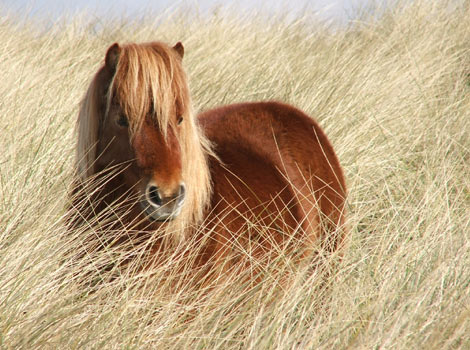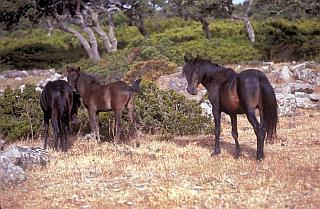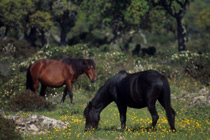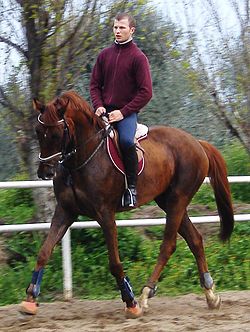|
Home Horse Breeds | First Posted: July 29, 2009 May 13, 2020 | |
Achetta, Sardinian Pony (Giara or Jara), Sardinian Anglo-Arab Horse
 Achetta Pony
 Sardinian Ponies
 Giara Ponies
 Sardinian Anglo-Arab Horse
Achetta PonyThe Achetta Pony is a breed that comes from Italy. Their ancestors were brought in the second half of the 20th century. In my research there seemed to be some confusion about the Achetta and the Sardinian Pony. Sometimes the names were used interchangeably and sometimes not.
Sardinian Anglo-Arab HorseHistory For many centuries Sardinia imported many horses, basing its island breed on crosses between Arabians and Barbs. Sardinia traded with North Africa so North African Barb Horses and Arabian Horses easily imported. They were the foundation stock for the present Sardinian Horses. In the 15th century, after Ferdinand of Spain (1452-1516) founded a stud of Spanish horses now called Andalusian near Abbasanta, a distinctive type of horses began to appear. The stud made stallions available to local breeders and other studs were later established at Monte Minerva, Padromannu and Mores. The horses produced became famous as tough saddle horses with great stamina. However, when Sardinia passed from Spain to the House of Savoy in 1720, horse breeding declined. It was only at the beginning of the 20th century that the breed revived, when in 1908, Arabian horses were again imported to improve the stock. Later on, the introduction of Thoroughbred blood resulted in the modern Sardinian, which is now very much Anglo-Arabian in type. Physical Description These horses now have refined heads, elegantly arched light necks, good conformations, are 15.1-16.1 hh, are bay and brown. Their temperaments are bold and intelligent, but they are generally well grounded. Uses The Sardinian Horse is used in equestrian sports and for pleasure and show riding.
Sardinian PonyHistory There is not much known about the development of the Sardinian Pony. It is now quite rare. The Sardinian Pony is an ancient breed. Barbs and Arabian stock were used major in its development as well as horses of Spanish descent. There are records that date from 1845 on this pony but not many. The true origin of these ponies is not known. Physical Description The Sardinian Pony (see more on the Sardinian Horse below) stands between 12 and 13 hands high at the withers. It is small in stature but has horse characteristics. They have heavy heads, straight or convex profiles, small, alert ears, and large, intelligent eyes. The neck is muscular, with a good arch from the withers to the poll. Their backs are short and compact but tend to be hollow. The croup is sloping with a low-set tail. The shoulders have a nice slope and are powerful. They are deep and wide through the chest. They have long legs. The bone is very fine but the legs are strong. The hooves are tough. They tend to be cow hocked. Usually these ponies are brown, black, bay, or liver chestnut. Their temperament is usually quiet, however, they can be stubborn. They are easy keepers and are tough, and resistant to unfavorable weather conditions. Many of the feral ponies of this breed live 2,000 feet above sea level on harsh plateaus. They have learned to adapt for survival. Uses When domesticated these ponies are good for riding, light draft work, and light farm work. They are also used for trekking and packing. Giara Pony, Jara or "Cavallino della Giara" History of the Wild Ponies The Giara plateau has had wild ponies ranging freely for centuries. They are the last surviving horses of a breed which used to populate the entire island. Due to its natural isolation, the Giara of Gesturi has been able to offer these ponies protection in a natural habitat with ideal conditions which have preserved their unique characteristics. Their presence in Sardinia probably dates from the pre-Roman period. They may have been imported from Numidia by the Carthaginians. Since Medieval times these ponies were used for threshing. The female ponies were captured at the beginning of summer, worked all season in the fields of the Campidano and were then set free on the Giara. Therefore, although these ponies have an owner they run wild almost year round on the Giara. With the mechanization of agriculture in the second half of the XXth century the agricultural use of the horses declined and the horses began to be butchered for their meat. The population of ponies on the Giara declined rapidly. To increase both their numbers and their size, stallions were released on the Giara. As a result, the original characteristics of the ponies suffered progressive deterioration. Horses with light colored manes and white piebald horses began to become common. Concurrently a movement of experts and "fans" of the little ponies began to defend the ponies of the Giara of Gesturi. In the 70's a campaign to protect the ponies with the traditional characteristics took full sail. The ponies with the traditional characteristics were separated from the other horses and the Giara once again became home to a unique breed of little ponies. Physical Description Their head is short and angular, with heavy jaws, a muscular neck, and almond shaped eyes. The wither is flat, their back is short and flat; the croup short, the tail set is low. The mane and tail are thick and long. The chest is fairly narrow, and not very deep. The legs appear fine boned, the hooves are small and extremely hard. Giaras are rather short-strided, but are forward moving and sure footed. Size is usually between 120 cm at the shoulders or 11.3hh and 130 cm to 140 cm at the withers or 12.2 - 14 hh. The Giara Pony is bay, sorrel or chestnut in color. They are extremely hardy, easy keepers, and can survive on little forage. Giaras have been used as riding horses, both, in sport activities and pleasure riding. They have a reputation of being often a little difficult in temperament and character, somewhat on the nervous side, and need a competent handler or rider. The Giara pony is not the easy going, sweet natured pony suitable for beginners. It will not have a happy future in tourism. Uses The ponies are used for riding, agriculture, and meat. The Ponies Today Every summer the horses are rounded up and taken off the plateau where they are easily led into stone corrals. The round up is done to protect the ponies. At the end of August food for the ponies on the Giara is scarce and the newborn ponies have to be branded. Each pony is given 3 brands: a G which certifies that the ponies are from the Giara; their owners brand and a brand which identifies the municipality which they come from. Since 1996 the XXV Comunità Montana has been buying the ponies from the families who live in the nearby villages and it now owns about 200 of the approximately 500 ponies that live on the Giara. The branding (which is a centuries-old tradition) starts with a horse race which is called is insocadores. The jockeys are the riders who round up the ponies. Later a committee of experts decides on which ponies are "pure blood Giara ponies" and those ponies which are deemed not to be pure enough are branded with an R and taken off the Giara. In September the ponies are released to run wild again on the Giara. Herds can often be seen near is paulis. Giara Pony
A Sardinian Horse, Sardinian Anglo-Arab, Anglo-Arabo-Sardo, AAS
The Sardinian, Sardinian Anglo-Arab, or Anglo-Arabo-Sardo (AAS), is a horse breed that was established in Sardinia, originating from the crossing of Thoroughbred with Sardinian horses carrying Arabian blood. Its origins in Italy trace to Sardinia, where it has been selectively bred for more than one hundred years. HistoryIn 1874 The Ozieri Army Remount Station was established to supply mounts for the cavalry units of the Italian Army. To produce horses suitable for the cavalry, indigenous Sardinian mares were crossed with oriental-bred stallions such as the foundation sire Osmanié, and, starting from 1883, also with French-bred Anglo-Arabian stallions. In 1915, captain Grattarola, director of the Ozieri Remount Station, continued the work by crossing the best 600 available mares with stallions of Purosangue Orientale breeding, using as his founding stallions Abbajan Sciarragh, Talata u Kamsin and Etnen u Kamsin, which had all been purchased directly from Bedouin desert tribes. Later on, Thoroughbred stallions started to be utilized on the mares of mixed Sardinian and oriental ancestry. One such Thoroughbred stallion was Rigogolo (son of Havresac II). A goal of a minimum of 25% Arabian blood was set. In 1967 the breed was officially named "Anglo-Arabo Sardo" (abbreviated in AAS). Lately the suffix "sardo" has been dropped and the breed is increasingly being promoted as an Anglo-Arabian horse. Related breedsThere is also a smaller native horse called the Giara's Horse, which is thought to have developed from Numidian (North African-possibly Barb) stock brought to the island by the Carthaginians in Roman times. It is these native horses that crossed first with Arabians and then Thoroughbreds, that provided the local foundation bloodstock that contributed to the creation of the Sardinian horse. The Government remount station in Ozieri is now crossing the Giara Horse with Arabians, Small AAS and even German riding Ponies in an effort to produce a pony ideally suited to equestrian sports, and is creating the "Giarab" pony breed. Many specimens of AAS are contributing to the foundation bloodstock of a new breed, named the "Sella Italiano" or Italian Saddle Horse. UsesSince the 1960s the AAS has proven itself in the sport of eventing and has also established itself as a racehorse and a steeplechaser. In 1990, Ostenda, an AAS horse won the Grand Prix des Pouliches in Tarbes, and the mare Vituliana repeated this feat in 1997. Vidoc, an AAS stallion, placed first in the Prix du Ministere in 1997. The majority of horses competing in the Palio Di Siena belong to the Anglo Arabo Sardo breed. They replaced the Thoroughbred for racing in the Palio di Siena after several horses had fractured their legs in the tight turns of the Siena Square, so they were replaced by the shorter and sturdier breed whose legs can better withstand the stress of the race. This horse also plays an important role in the folk festivals of Sardinia's horse culture such as the Sartiglia di Oristano, The Cavalcata Sarda and the Ardia di Sedilo. CharacteristicsDolichomorphic: bay, chestnut or gray. Height at the withers: small type (156-158 cm or 62.2"), medium type (158-165 cm) large type (taller than 165 cm. or 65" Weight: 450 - 550 kg. (992 lbs. - 1212.50 lbs.) It is characterized by solid feet and legs, a refined head with a straight profile and a fiery temperament with speed and stamina. In Cavalry trials it was able to cover 100 kilometers per day for several days. For More Information: |